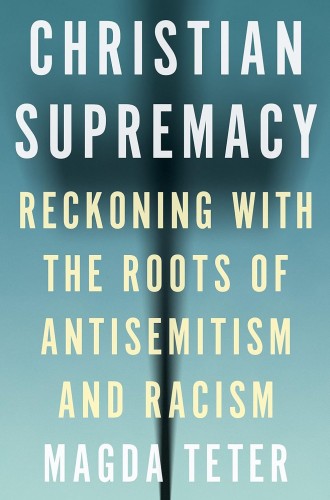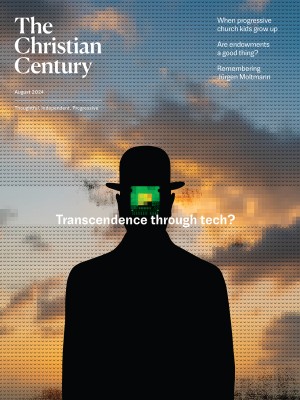The shared root of antisemitism and White supremacy
Historian Magda Teter identifies an endemic rot at the center of Christianity.

Christian Supremacy
Reckoning with the Roots of Antisemitism and Racism
In 2018, early in my teaching career, a bright college student challenged me to connect the course I was teaching on the history of the Holocaust to concerns about White supremacy and religious intolerance in our own campus community. The underlying question, of course, was this: How do events of the European past resonate with the issues facing 21st-century America? My student’s call to address the intersectionality of these histories has stayed with me through pandemic shutdowns, George Floyd, January 6, two cross-country moves, a career shift, and the continuing rise in antisemitism.
Magda Teter’s Christian Supremacy provides a timely answer to precisely this question. Her book enters a growing conversation about White supremacy and Christianity—not just their intersections but the inextricable communion of Christian religion with racism—at an important moment. She draws on a wealth of sources, including theology, legal treatises, and visual culture, to chart how the subordination of Jews became structural and contributed to European ideas of Christian domination. Christian Supremacy reminds us that interreligious debates and religious chauvinism are hardly modern inventions. Within the medieval context, thinkers struggling with definitions of religious identity defined themselves implicitly against other religious communities, especially Jews, who were cast as people of servitude.
Read our latest issue or browse back issues.
Anti-Jewish and anti-Black stereotypes in sacred practice and iconography reflect a Christian supremacist society.
Theologians and scholars, such as the late Black liberation theologian James Cone, have long grappled with the racist roots of Christianity. More recently, Anthea Butler and Danté Stewart have released salient reckonings with Christian supremacy in White evangelical circles, firmly grounded in a history of anti-Black violence in the American church. US Christianity’s racist, misogynist heritage has also been central in recently published historical explorations, such as Kathryn Gin Lum’s Heathen and Kristin Kobes Du Mez’s Jesus and John Wayne. Teter’s detailed account adds a crucial element to these conversations by connecting Christian supremacy’s embeddedness in society with a long history of antisemitism.
Teter frames her work by quoting James Baldwin’s assertion that “the Christian world has revealed itself as morally bankrupt and politically unstable” in the wake of the Holocaust. Baldwin knew that Christian communities on both sides of the Atlantic upheld White supremacy and its systems of violence, and that what happened in Europe and North Africa during the Second World War could be replicated anywhere. It is precisely this tradition of European Christian identity that served as the foundation for discrimination, colonialism, enslavement, and even genocide. Teter further traces the historical genealogy of White supremacy as it intertwines with Christianity, from the earliest formulations of Christian identity to backlash against movements toward Jewish and Black equality in the United States to the unresolved legacies of antisemitism and racism that continue to haunt our largely segregated religious congregations.
Certainly, there are nuances that complicate a comparison of the experiences of marginalized groups, and a deeper exploration of economic injustices might paint a more complicated picture. Nevertheless, Teter isn’t trying to make universal claims but rather to identify an endemic, historical rot at the center of Christianity. By pointing to the shared histories of marginalization, Teter warns against false equivalences and engaging “in competition over who was hated and who suffered more.” She focuses instead on the shared theological foundations of antisemitism, Islamophobia, and anti-Black racism. She doesn’t simply put these racist and xenophobic perspectives in conversation; she reveals that the ideology at the center of each of these forms of violence is in fact rooted in the same premodern idea of “Christian racial populism” that envisions a societal division between White Christians and everyone else.
The modern idea of a civic society, where inclusion is based on political rather than ethnic or religious identity, holds little appeal for Christian supremacists, Teter shows. Practices in the 20th-century United States, Nazi Germany, and apartheid South Africa reflected Christian ideas of social and religious hierarchy that were often at odds with Enlightenment notions of civic equality and pluralism. Teter claims that the current rejection of the equality of Jews, Black people, and other marginalized populations in both the United States and Europe stems from an ancient theological claim—later codified in law and social order—of Christian superiority.
Religious readers will find particularly compelling Teter’s evidence for how anti-Jewish and anti-Black stereotypes in sacred practice and iconography reflect a Christian supremacist society. For instance, through the evolving images of Synagoga and Ecclesia—signifying Jewish learning and the new Christian teachings, respectively—Teter shows how Christianity shifted from supersessionism and a publicly humiliated Synagoga to a revised image meant to show interreligious dialogue. Still, the postwar reimagining of the two sitting together reading each other’s sacred texts depended on the same religious hierarchy, in which Christianity is dominant.
If I were again teaching classes in European history and the Holocaust, Christian Supremacy would be required reading. Moreover, Teter’s history deserves attention beyond the university classroom or lecture hall. Christians of any persuasion should spend time with this book and look past the comfortable narrative we often paint of ourselves, that of belonging to a religion of love and justice. For meaningful interreligious dialogue to occur, Christians should identify and come to terms with the consequences of these difficult histories of racism and antisemitism as well as their continued participation in systems of oppression.
Christian Supremacy is more than a deep history of European racism and the role of Christianity in perpetuating violence. It is an evocative call for Christians to closely examine our unconscious habits, our iconography, and the identities we proclaim. It is an invocation to recognize and remove the decay of centuries of hate before it once again becomes “a deadly social force.”
The views expressed are those of the author and do not represent those of her employer.





